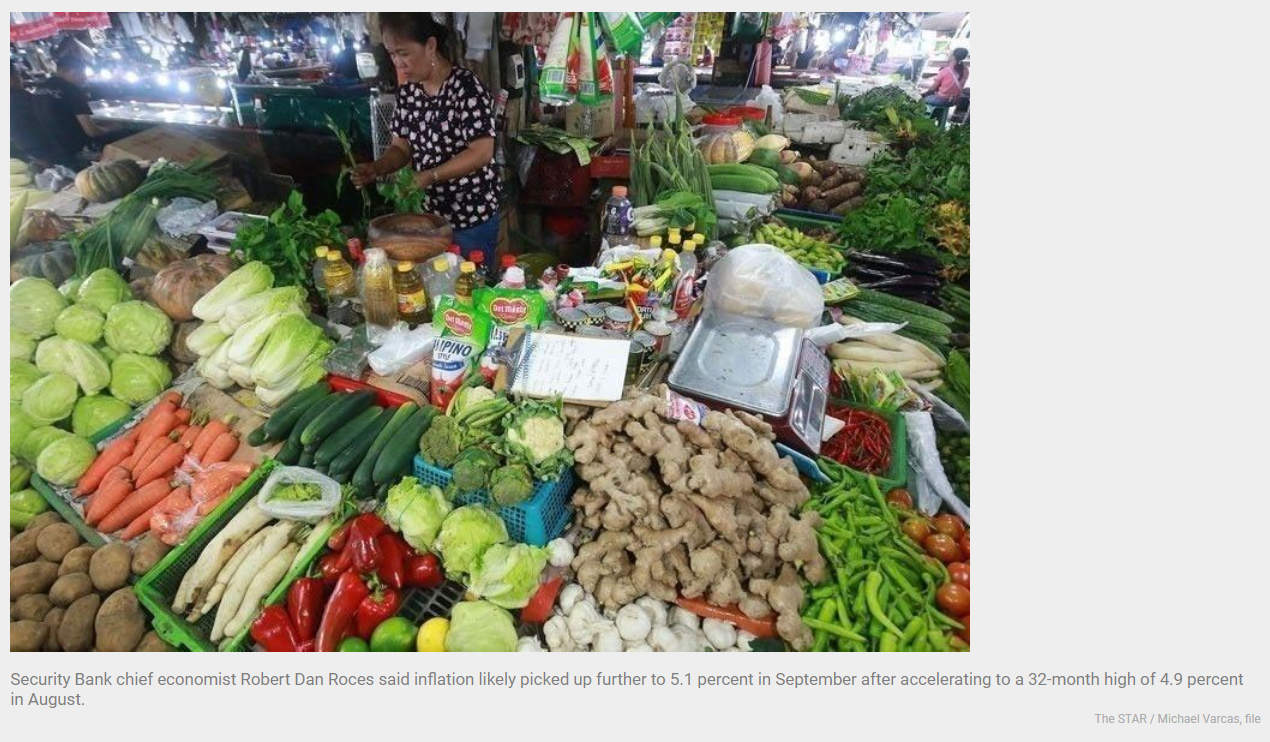Philippines: Inflation seen topping 5% in September
MANILA, Philippines — Inflation likely accelerated for the second straight month in September, breaching the five percent level for the first time in almost three years on the back of elevated food prices, rising pump prices of petroleum products, and more expensive power rates.
Security Bank chief economist Robert Dan Roces said inflation likely picked up further to 5.1 percent in September after accelerating to a 32-month high of 4.9 percent in August.
The last time inflation breached five percent was in December 2018 when the consumer price index (CPI) settled at 5.1 percent.
Security Bank expects inflation to settle between 4.9 and 5.3 percent in September.
Roces said fish and lowland vegetable prices remained elevated in September, offsetting the small dip in vegetable and pork prices.
Furthermore, Roces said power rates in areas serviced by Manila Electric Co. (Meralco) climbed to reach a year-high of P9.1091 per kilowatt-hour in September, while oil companies further raised pump prices last month.
As a result, Roces said, utilities and transport baskets likely accelerated by 0.8 percent and 0.1 percent month-on-month, respectively.
Likewise, the restaurants and services basket may have gone up by 0.6 percent on the back of looser community quarantine curbs.
“We currently expect inflation to average 4.5 percent for 2021, although we are monitoring food and oil price movements as we see these being the primary upside risks in the months ahead,” Roces said.
UnionBank chief economist Ruben Carlo Asuncion said inflation may peak at 5.1 percent in September as prices of food, fuel and utilities remained elevated.
“Our forecasts tell us that September will be the peak and November is the start of the easing,” Asuncion said.
The BSP sees inflation breaching five percent in September before easing back to within the two to four percent target starting November. Inflation averaged 4.4 percent from January to August due to supply-side shocks caused by weather disturbances and the African swine fever (ASF) outbreak.
In its latest assessment, the BSP raised its inflation forecasts to 4.4 percent for this year, 3.3 percent for next year and 3.2 percent for 2023.
ING Bank Manila senior economist Nicholas Mapa said inflation likely hit five percent in September due to the impact of rising global energy costs on domestic utilities and operation of private vehicles as well as the pick-up in food prices.
“Inclement weather and the stubborn proliferation of ASF forced food inflation to a startling 6.5 percent last month and as usual food inflation will be key in the direction and pace of inflation for the September print,” Mapa said.
Mapa explained food inflation may come off the peak of 6.5 percent posted in August as prices of select upland vegetables normalize while both meat and fish prices also dip slightly.
“Prices for basic commodities, however, remain still quite pricey and we hope these trends continue,” Mapa said
As inflation expectations remain anchored, Mapa said the BSP would likely keep rates on hold possibly until June 2022 despite the recent double peak of inflation.
Mapa pointed out the headline print is widely expected to dip back within target by as early as November as base effects turn favorable.
“With the central bank helping support the recovery, we have always expected the eventual policy reversal to take place sometime in the second quarter of 2022, even if inflation by then would have reverted back to target. A gradual and well-timed exit strategy will always work best as opposed to haphazardly hiking rates which will undoubtedly reverse the gains made by the economy so far,” Mapa said.
Alvin Arogo, economist at Philippine National Bank, also believes inflation likely peaked at five percent in September, mainly driven by the slightly lower base and higher prices of food, electricity and miscellaneous services.
Source: https://www.philstar.com/business/2021/10/04/2131532/inflation-seen-topping-5-september


 Thailand
Thailand




